Sakasa Kebari are Awesome – but NOT the only game in town
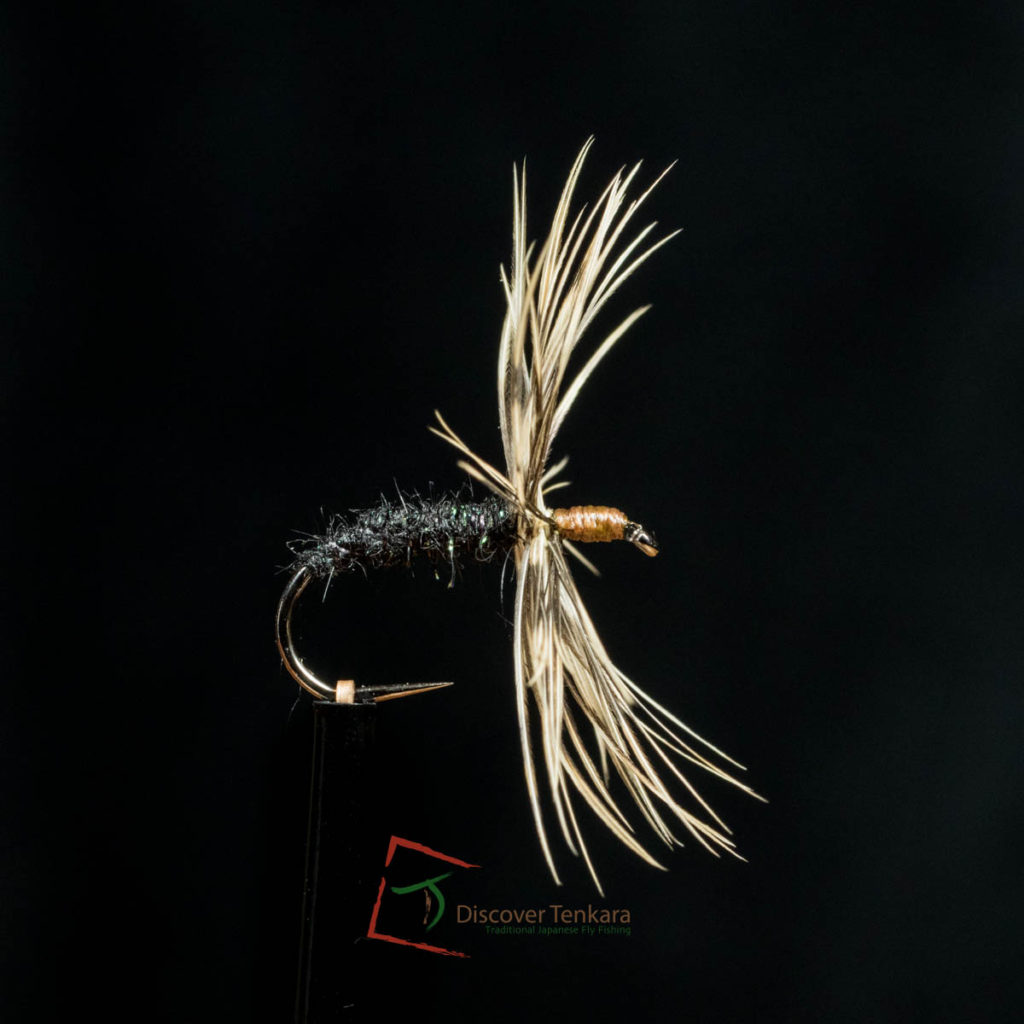
No one can argue that the long soft hackled sakasa kebari style – with their “backwards” hackle has become the icon of tenkara flies in the west. These flies are so different from what we recognise as a conventional western fly that it’s no wonder they captured the imagination of fledgling tenkara anglers exploring this new and exotic fishing experience.
Before we go any further I’d just like to get one thing straight… what follows here is in no way an attempt to spoil anyone’s fun or to tell you how you should be fishing or tying your tenkara flies. The purpose of this post is to share some interesting facts about the flies of tenkara and hopefully get people exploring the rich tapestry of patterns that can be found in Japan. In fact, one of the most surprising things about some of the flies in “the other 75%” of patterns used in Japan is the STIFF hackled WET fly. In many ways, that is even more weird than a sakasa hackle.
Early experiments with Japanese tenkara flies
Like many people new to tenkara both me and Paul spent our early days exploring reverse hackle patterns both in traditional Japanese patterns such as the Takayama style (or the less well known Okumikawa style) and initially with a few adapted western patterns too. In those early days of tenkara’s spread outside Japan source information in English was difficult to find and Yoshikazu Fujioka’s website “My Best Streams” was (and still is) a great source of information for anyone interested in traditional regional tenkara patterns.
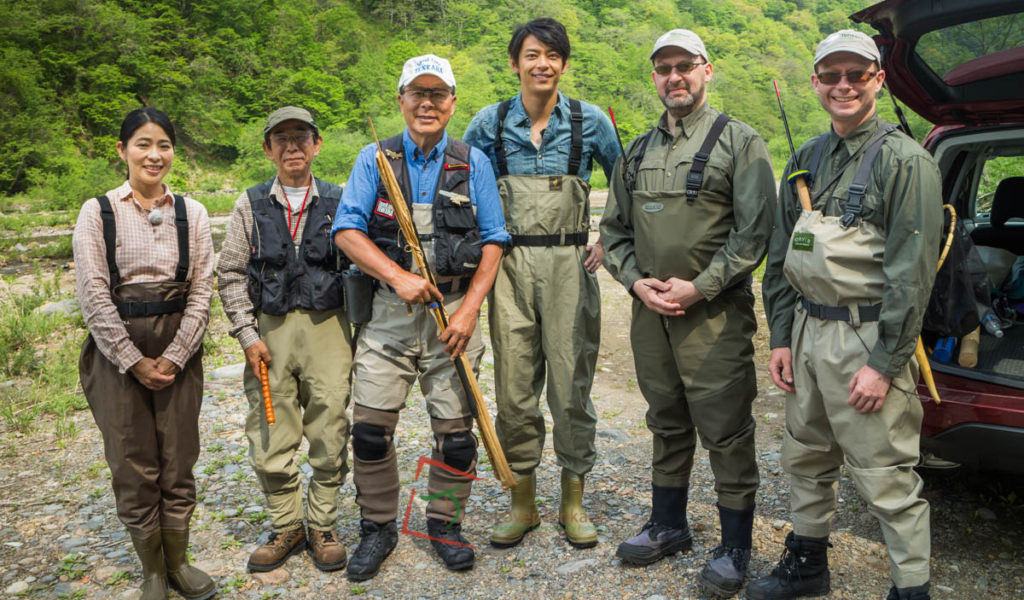
In 2014 we decided to visit the mountain streams of Japan to begin our own research into the attitudes of tenkara anglers to their flies for our (now discontinued) Vol.2 DVD. What we discovered has drawn us back to Japan every year since and has become the subject matter for 2 DVDs and our very first Print Book (Click the following link for full details of the book “How to Fool Fish With Simple Flies: The Secret Science Behind Japanese Kebari and Euro Nymph Patterns“).
In all of our research and in interviewing some of the best tenkara practitioners in Japan we started to realize that the iconic fly of tenkara, the “sakasa kebari”, was not the no.1 fly choice of for a great number of tenkara anglers. This is not to say that the sakasa style has no place… quite the opposite in fact; almost everyone we interviewed had some sakasa kebari patterns in their fly box but they are normally reserved for specific scenarios INSTEAD of being the go-to pattern for all round fishing duties.
So, what is the No.1 Tenkara Fly? Enter the Futsuu Kebari
The most frequent kebari style we’ve observed in our studies use stiff rooster hackles which look very much like western dry fly hackles (BUT are actually wet flies). The examples below are just a few of the go-to patterns shared with us by anglers in Japan.
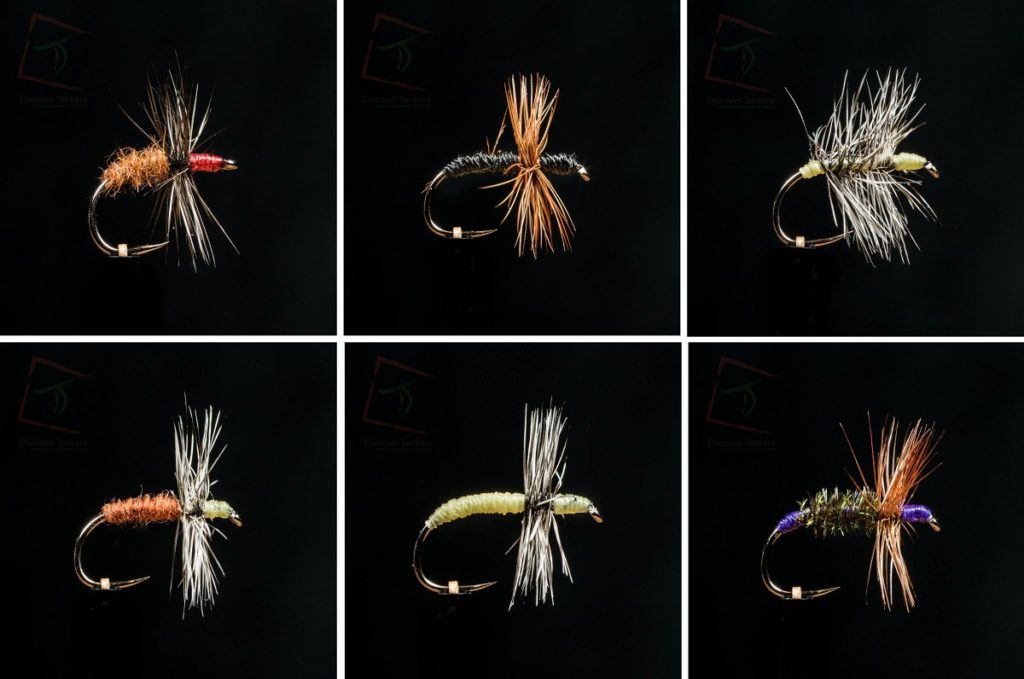
A hackle style which is often referred to as “futsuu” (pronounced “fut-soo” or more accurately “f’t-soo“)
and translates as “regular” (in direct contrast to “sakasa” meaning
reversed) describes a simple rooster hackle, wound so that the barbs
stick out roughly perpendicular to the hook shank is actually the most
common kebari that we’ve seen in use in Japan.
These stiff hackle kebari are not unheard of in the west but they are often not recognised or fully appreciated for what they are… we’ve seen several instances where well known and respected western angling writers have mistakenly referred to jun kebari styles as “tenkara dry flies”. Well, OK it is physically possible to fish them as dry flies – BUT their major function is to be fished as a wet fly pattern…and here’s how to tie a great one:
So, what’s so good about these kebari?
A stiff hackled kebari/wet fly can offer significant physical or mechanical advantages over soft hackled sakasa patterns; a few of which include,
– maintaining profile in strong flows
– improved aerodynamics for more accurate casting
– the ability to “anchor” the fly in opposing current
– increased vibration/disturbance when manipulated
If you’ve never experimented with stiff hackled wets I would strongly urge you to give them a try. It’s no coincidence that they are the No.1 choice for so many Japanese tenkara anglers… they reward anglers ability; for example, allowing skilled casters to achieve pinpoint presentation or light line users to keep their fly in the same spot for longer.
But that’s not the end of the story…
For one thing, there is not a completely general agreement on what a “REAL” sakasa kebari actually is in Japan. In addition to that, there is yet another type of “regular” hackled fly which is incredibly popular and effective in Japan (the “Jun kebari” style). Don’t worry, it sounds more complicated that it actually is.
Let’s deal with “real” sasaka’s first.
Sebata-san’s Definition of a Sakasa Kebari
Mr Yuzo Sebata is a colossal figure in Japanese tenkara. He actually independently developed the “genryu” style of tenkara (hazardous and adventurous combination of camping, cliff and waterfall climbing, living off the land combined with fishing in remote wilderness headwaters). In the process he also invented “sawanobori” or “waterfall climbing” as an independent pastime on it’s own too. Over his 50-year plus tenkara career he has also done huge amounts of work to publish and promote tenkara as a valid fishing style – especially in the magazines and videos of the fly fishing industry in Japan.
In Sebata-san’s opinion, the kebari pictured at the top of this article would just be a “regular” hackle. He wouldn’t consider it Extreme enough to count as a true sakasa kebari. Instead, the style of dressing being demonstrated by Kobayashi-san in the picture below has both the density and severe “cone” shape that Sebata-san requires for a fly to qualify as a real-deal reverse hackle pattern.
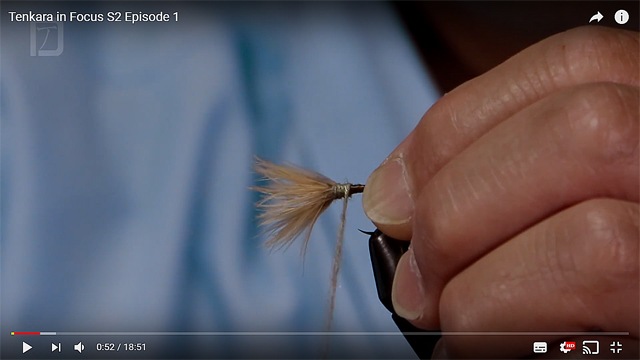
The important thing to know is that you will find a range of opinions on how “reversed” a hackle needs to be before it qualifies as “reversed enough”. Of course, Sebata-san’s opinion is highly respected, but I’m not sure how widely he has spoken on that one specific subject. It could be very much like the almost unknown fact that he pretty much set the meaning and the use of the word “tenkara” for the style of traditional (reel-less) Japanese fly fishing in magazines when they began to run more stories on this unusual method from the 1980’s onwards. Even in Japan, not many folks know that the editor of one of Japan’s most prominent fishing magazines (Tsuribito) asked Sebata san whether it should be just called “kebari tsuri” (fly fishing) or “tenkara”. Both phrases were used pretty interchangeably at the time – so Sebata san’s decision to define and use “tenkara” very specifically is the reason that you can buy a “tenkara” rod today (and even visit a “Discover Tenkara” website).
Jun Kebari – another “normal” style of hackle
While futsuu generally refers to stiffer-hackled kebari (again, you may see some variation as with any common-use/non-scientific word), the term “Jun” usually refers to swept-back soft hackles. The word itself means “normal” – but it carries a feeling of a “conforming” or “following along with” kind of “normal”. For this reason, it naturally describes a softer hackle which, by being swept back along the shank, conforms more to the shank of the hook (especially when it is moving forwards).
This is a point that David Walker deduced very well from some of his research of Japanese shop websites selling kebari – and it is great to have been able to confirm that by talking to a number of top-class anglers on our most recent research trips to Japan.
Because these are a lot more familiar to the eye of western wet fly fishers, Jun kebari are often overlooked and – Big Mistake – underestimated. Look out for more coverage on a special tactic developed by Takahashi-san (Mr. Shin Takahashi) where he combines a nymphing approach with tenkara manipulations. He noted that many times fish will grab the fly on the “pause” between two manipulations. Takahashi san also took careful note that sakasa kebari hackles open when you pull the fly – versus a special rig using a weighted fly to make the jun kebari hackle open when you pause the fly.
All in all, the different textures and directions of hackles are matched to their ideal presentation method that lets tenkara anglers take advantage of a really wide range of conditions.
That’s why, looking into many top Japanese anglers’ fly boxes will often look something like this:
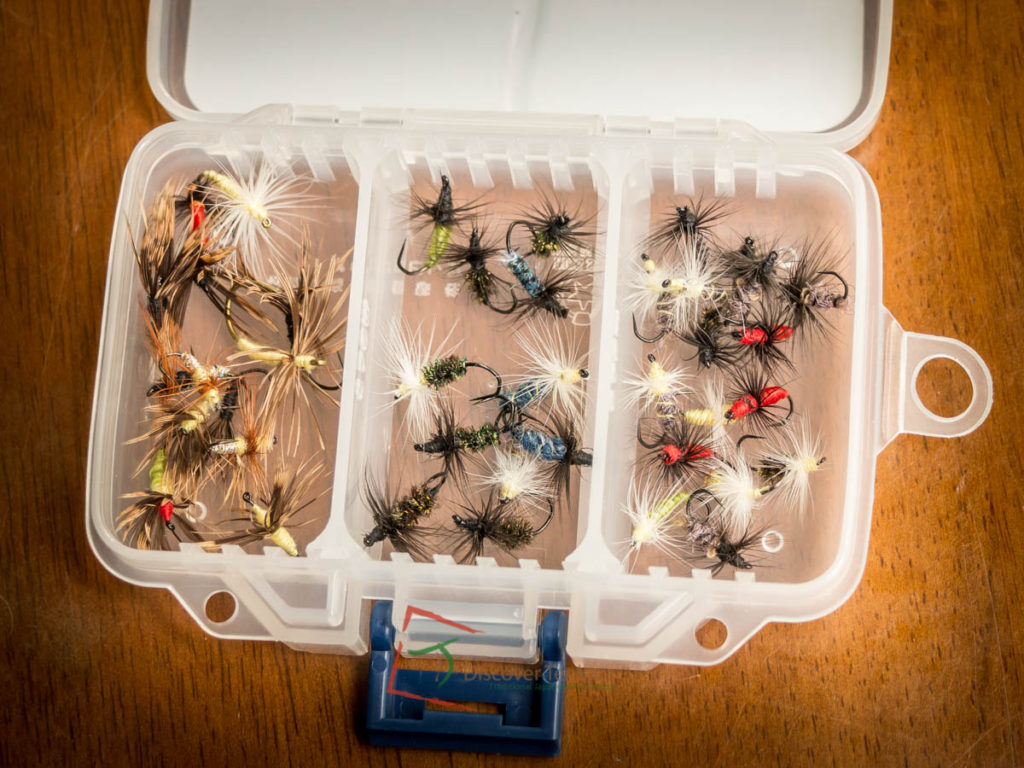
Want a second opinion?
It’s hard to ignore the facts… in addition to the extensive research Paul and I have carried out in Japan and all the help we’ve had from dozens of anglers that folks like Go Ishii and Dr. Ishigaki have introduced us to, Yoshikazu Fujioka has done extensive studies on Japanese kebari styles.
How extensive? Well, believe it or not Fujioka san actually recorded and then plotted the frequency of various hackle styles. The numbers he found reflect that normal stiff hackled kebari are the most popular in Japan by a long way….
Would you like to see? Well, (believe it or not) Fujioka san is kind enough to publish his graphs on PAGE 2 of the document on this link on his great and extensive (English Language!) site:
CLICK HERE TO SEE PDF (don’t forget to scroll to page 2 to see the “radar plots”)
Some figures from Fujioka san’s results,
- Frequency of long/soft/reverse hackle (the “classic” sakasa style) – 11.7%
- Frequency of short/stiff/normal hackle – 38.5%
Because flies with stiff hackles are amazing for some of the most effective “anchoring” and “water-disturbing” presentations – you’re missing a HUGE chunk of tenkara opportunities if they aren’t in your armoury. So, if you’d like to lock in some tried and tested stiff hackled patterns; Click the link below and have a really close look at out our new range of kebari sets here.
JP and PG

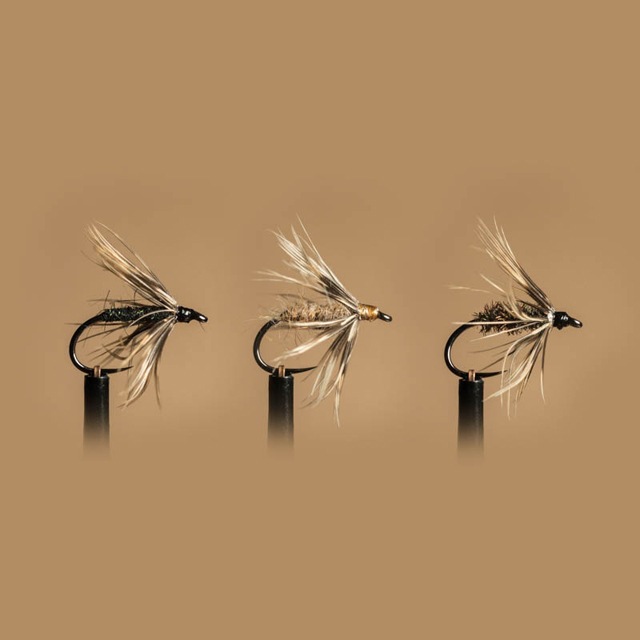
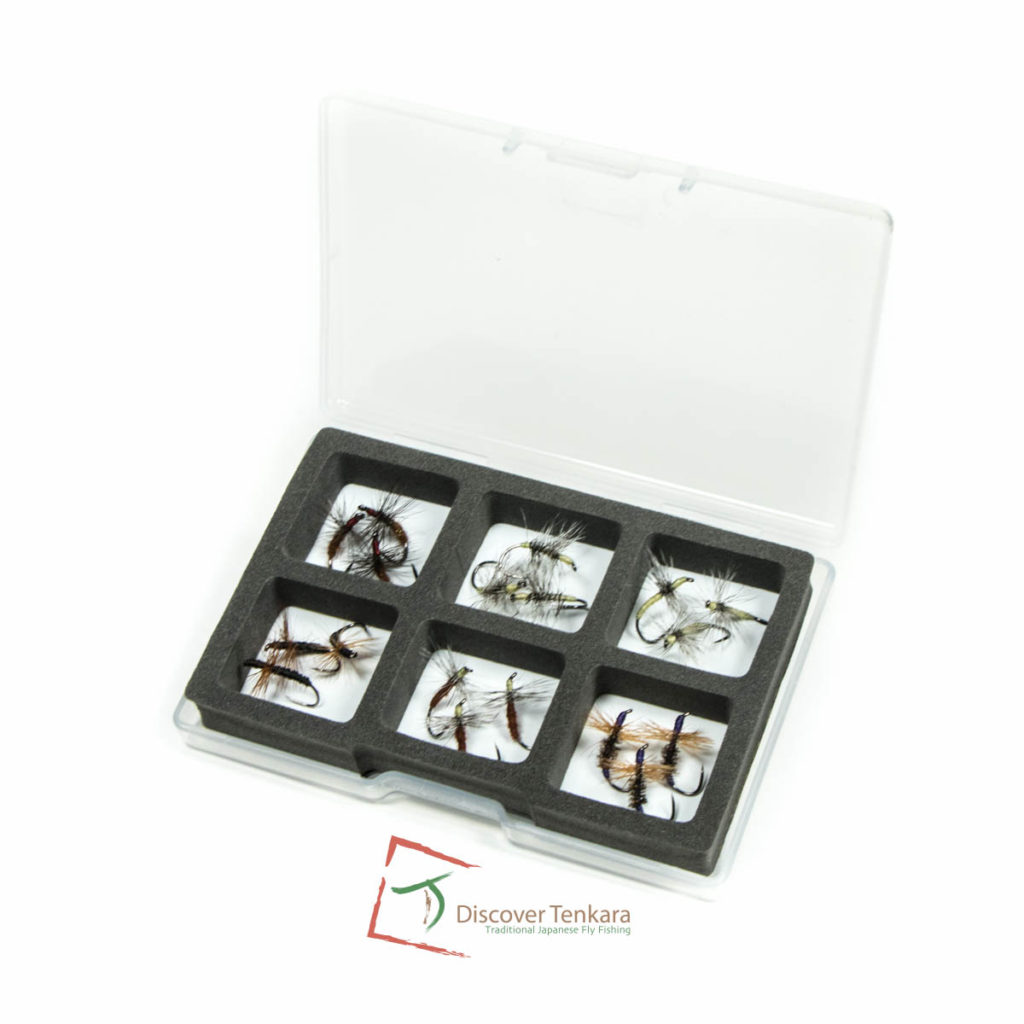
Nicely written post here. I’m not surprised however, being as the soft hackle fly is meant to emulate an emerger, which is usually a lesser event in stream life cycle. Thank you for the great inspiration. Bob.
Doesn’t the stiff hackle move less in the water and slow the fly from sinking?
That’s a really great question Jason, thanks for taking the time to read and comment.
There are so many variables it’s almost impossible to say whether one would sink faster than the other.
If you think about it, for any given hook size, stiff hackles often tend to be of a smaller size when compared to soft hackles so there’s the hydrodynamic advantage of a lower profile there; stiff hackle tends to have virtually no barbules on the fibres whereas soft hackles tend to have a lot more barbules along each hackle fibre, which again gives a hydrodynamic advantage to the stiff hackle.
On the other hand stiff hackles can be denser in their fibre count so for any given number of turns you’re likely to have a fly with more fibres of hackle for the same number of wraps with stiff hackle.
I’m sure with some careful tying it would be possible to make a soft hackle kebari that could sink faster than a stiff hackle or vice versa.
I’ve seen quite a few tyings from Japanese tenkara anglers where they’ve used dry fly dubbings or polypropylene yarn for the body which would suggest that (at least in these examples) sink rate is not a big consideration. Also their use of fine wire hooks may support this theory.
I’ve also seen Dr Ishigaki chew the hackles off flies when fishing with him in Japan – this would obviously make them sink quicker (but this was not his primary reason for doing it).
When you add in the possibility of using down-welling currents on stream, the sink rate between the two styles of fly seems less important than the individual angler’s skill in achieving depth through other means. That being said, in strong currents you may actually lose some ability to “sail” your fly in that current with soft hackles as they tend to become more streamlined in very strong flows.
Long before I heard you guys throw out the name Jun Kebari (順毛鉤) I had read about the Futsū kebari (普通毛鉤).
Jun kebari most frequently translates as Order fly, but sometimes as Forward fly. Leading me to think a Jun Kebari has the hackle pointing toward the hook bend. Forward not reversed, or upside down, aka opposite of Sakasa Kebari.
Futsū kebari always translates as – ordinary , common, usual fly. Leaving me to think a Futsū kebari has a neutral hackle. Neither forward or reverse facing. I think I see a lot of flies people call a sakasa kebari but they are really Futsū kebari. This thinking, that it means a neutral hackle orientation, was reinforced by a Fuji Hiromichi post called 冨士流「普通毛ばり」を巻く, Fuji Style “futsū kebari” winding. The bottom one.
http://orange.zero.jp/tenkarakai.wing/kouza/kouza3.htm
Typing in – futsuu kebari or futuu kebari will give you the same kanji 普通毛鉤.
All that to ask this. What is the difference between a Jun Kebari and a Futsū kebari ? Or is there a difference?
Though they seem to be two different types of kebari. Often the names appear to be used interchangeably. Or not strictly adhered to. But there must be a better definition than just – not a sakasa kebari. Anyway for a couple of years now and again I’ve written that I think the sakasa kebari needs to share the icon spotlight on the world of tenkara stage with the Futsū kebari & 順毛鉤. Usually with the response that seems to say I’ve gone off my meds and I need some quiet time in the corner. Good article.
Thanks for taking the time to write David.
We’ve asked a lot of Japanese anglers about their ways of naming kebari and time after time we’ve been met with a puzzled look and an answer along the lines of “it’s just a kebari”.
There doesn’t seem to be any standardized scheme for the naming of kebari among Japanese anglers and the only time we’ve heard jun and futsū used it was a way of distinguishing the hackle style as “normal” or “regular” as opposed to sakasa.
Sorry the answer is a little mundane but from the conversations we’ve had with guys in Japan I get the impression (from their perspective) it’s a bit like discussing the size of a Coke in McDonald’s… is it regular, medium or standard?
People are genuinely missing out by focusing only on sakasa styles. Sakasa kebari definitely have their uses but those stiff hackled kebari/wet flies are just fantastic!
Opps. A typo at the end, … tenkara stage with the Futsū kebari & Jun kebari.
Direct link to the Fuji Style Futsū / Futuu kebari. The previous direction to it was, I think, a little vague.
http://orange.zero.jp/tenkarakai.wing/kouza/futuu.htm
Nice article. When he visited Utah in 2015 for Oni School, Sakakibara-San essentially made the same point to the students there: Sakasa kebari have incorrectly been promoted in the West as the main form of Japanese Tenkara fly.
Thanks MG,
Paul and I have been lucky enough to fish with Masami on more than one occasion in Japan. Last year we spent a couple of weeks with him and visited his famous fishing hut in Toyama. He uses a lot of stiff hackles but he also uses the sakasa style flies more than some of the Japanese anglers we’ve seen.
I suppose the sakasa kebari has become the stereotype in the west because it’s the one that stands out the most as being different and (almost) unique to tenkara – but, as with most stereotypes, it’s an oversimplification that latches on to the a single recognizable facet of a much more complex whole.